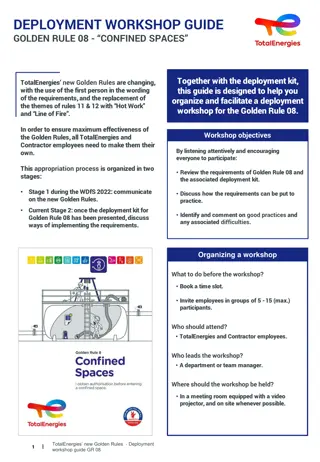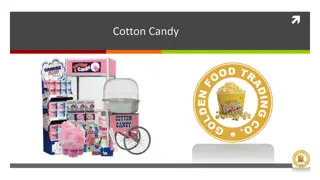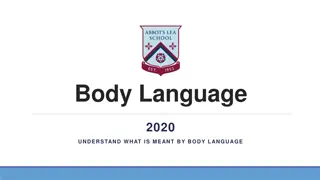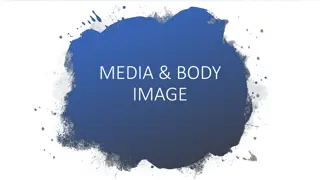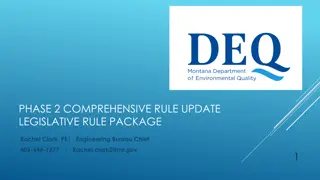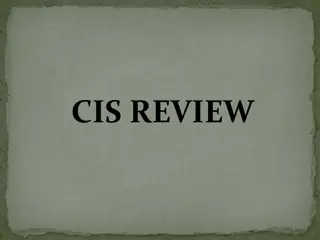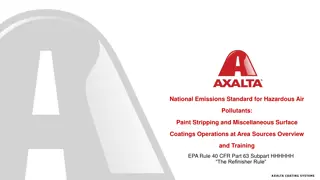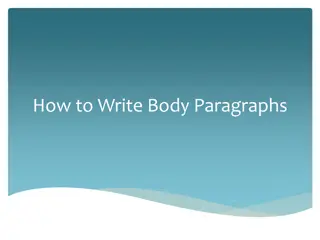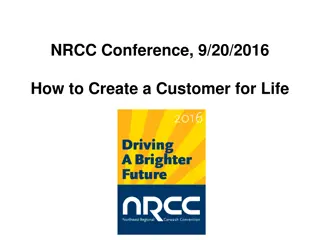Mastering Presentation Skills: Body Language, Golden Rule, and More
Discover essential tips for delivering powerful presentations, including body language cues, the rule of six for slide content, and strategies to engage your audience effectively. Learn about standing posture, hand gestures, emphasizing key points, managing nervousness, eye contact, speaking pace, and expressing enthusiasm. Follow the golden rule of limiting information to enhance audience retention. Enhance your presentation skills and captivate your audience with these insights.
Download Presentation

Please find below an Image/Link to download the presentation.
The content on the website is provided AS IS for your information and personal use only. It may not be sold, licensed, or shared on other websites without obtaining consent from the author. Download presentation by click this link. If you encounter any issues during the download, it is possible that the publisher has removed the file from their server.
E N D
Presentation Transcript
HOW TO MAKE A PRESENTATION BODY LANGUAGE QUIZ THE RULE OF SIX MAIN PARTS OF A PRESENTATION INTRODUCTION TODAY S TOPIC IS MY FIRST SLIDE SHOWS TO SUM UP
What do you think about making and giving presentations? How do you feel? For those who think that making and giving a presentation is a piece of cake, here is a quotation from an expert: The human brain is a wonderful organism. It works from the day we are born until the moment we stand up to speak in public. do your best try not to be scared or nervous and remember Great products need great presentations. 2
BODY LANGUAGE QUIZ YOU RE GIVING A PRESENTATION Do this quiz about body language first. Sometimes more than one answer is possible (circle your answers): 1. How should you stand? a) Arms crossed on chest. b) Straight but relaxed. c) Knees unlocked. 2. What should you do with your hands? a) Put hands on hips. b) Put one hand in a pocket. c) Keep hands by your side. 3
3. How can you emphasize something? a) Point finger at the audience. b) Move or lean forward to show that something is important. c) Use a pointer to draw attention to important facts. 4. What should you do when you feel nervous? a) Hold pen or cards in your hands. b) Walk back and forth. c) Look at the flip chart or screen (not at the audience). 5. How should you keep eye contact with the audience? a) Make eye contact with each individual often. b) Choose some individuals and look at them as often as possible. c) Spread attention around the audience. 4
6. How fast should you speak? a) About 20% more slowly than normal. b) Just as fast as in a normal conversation. c) Faster than in a normal conversation. 7. How should you express enthusiasm? a) By raising voice level. b) By waving arms. c) By making hand or arm gestures for important points. Suggested answers: 4. a 5.a/c 2.c 1.b 6. a 3. b/c 7. a/c 5
GOLDEN RULE Human attention is very limited. Don't cram too much information, either in each slide, or in the whole talk. Avoid details: they won't be remembered anyway. So, let s start with the rule of six. 6
THE RULE OF SIX When presenting a text on overheads or PowerPoint slides, it is a good idea to use the rule of six which means: a maximum of six lines per slide a maximum of six words per line If you stick to this rule, you won t risk overloading your bullet charts with too much information. 7
never write complete sentences, write bullet points, use different colours, font sizeatleast24, speak to the audience, don t read to them, keep don t use too many sound effects and animations 8
prefer an image to text, or/and graphs I ll show you two bar charts which illustrate/show the left bar chart explains 9
when test results are introduced in the table, the basic flowcharton the right will illustrate A B C D 1 2 3 4 5 6 10
or other useful visuals, such as: pie chart technical drawing 11
line graph organizational chart or organigram 12
INTRODUCTION Welcome audience: Good morning/afternoon, ladies and gentlemen. Hello/Hi, everyone. First of all, let me thank you all for coming here today. I m happy/delighted that so many of you could make it today. Introduce yourself (name, position/function): Let me introduce myself. I m /As you probably know I m a second year student at the Faculty of Electrical Engineering and Computing, University of Zagreb. For those of you who don t know me, my name s ..., I m a second year student at the Department of Electrical Engineering, Polytechnic of Zagreb. 13
TODAYS TOPIC IS State your topic: Since you are all students of Electrical Engineering, I m sure you are familiar with the topic of my presentation. Anyway I ll give you a short Summary. (Distribute your printed Summary to the audience). Take your time to read it and then I ll continue. As you can see on the screen, our topic today is ... Today s topic is . What I d like to present to you today is . The subject of my presentation today is . 14
Say why your topic is important for the audience: My talk is particularly relevant to those of you /us who . Today s topic is of particular interest to those of you/us who . The/My topic is very important for you because By the end of this talk you will be familiar with . Say how long the talk will be: My talk should take about 10 minutes. Please feel free to interrupt me at any time with questions. There will be time for questions after my presentation. 15
MY FIRST SLIDE SHOWS Say something about the Contents: I ll begin by showing you the main points of my presentation, these are . I d like to give you an overview of my presentation; first of all, I ll be talking about . I ll show you how I have divided my presentation. The main points are . 16
Continue with showing them your slides my first slide shows take a look at my first slide as you can see here ... let me just show you to illustrate this my next slide shows to illustrate this, let s have a closer look at I have a slide here that shows I d like to stress/highlight/emphasize the following point(s).. let me point out that I think you ll be surprised to see that what I d like to point out here is I d like to focus your attention to 17
TO SUM UP Signal the end of your presentation: I m now approaching the end of my presentation Well, this brings me to the end of my presentation OK, that s everything I wanted to say about As a final point, I d like to Before I stop, let me go over the key issues again Just to summarize the main points of my talk To conclude/In conclusion, I d like to To sum up 18
Just a few more tips Make appropriate use of pictures. It's a good idea to break up text with illustrations and it is true that a picture is worth a thousand words. Make appropriate use of anecdotes. A very short story or personal experience will act as an effective illustration of a point, add 'colour' to your presentation, and be remembered by listeners. The last slide should set out all appropriate contact details: certainly e-mail address and possibly snail mail address, plus the web site, Facebook page and Twitter address of your organisation and any personal website or blog if you have one. Have brief notes on postcard sized cards or have a handout that the audience can take afterwards. 19
Invite questions: Are there any questions? We just have time for a few questions. And now I ll be happy to answer any questions you may have. Dealing with questions/clarifying questions: I m afraid I didn t (quite) catch that. I m sorry; could you repeat your question, please? So, if I understood you correctly, you would like to know whether 20
Einstein's Driver The story is that Albert Einstein's driver used to sit at the back of the hall during each of his lectures, and after a period of time, remarked to Einstein that he could probably give the lecture himself, having heard it several times. 21
So at the next stop on the tour, Einstein & the driver switched places, with Einstein sitting at the back, in driver's uniform. The driver gave the lecture, flawlessly. At the end, a member of the audience asked a detailed question about some of the subject matter, upon which the lecturer replied, Well, the answer to that question is quite simple, I bet that even my driver, sitting up at the back, there, could answer it...'. 22
Avoiding giving an answer: If you don t mind, could we discuss that on another occasion? I m afraid that s not really what we re discussing today. Well, actually I d prefer not to discuss that today. Admitting you don t know: Sorry, that s not my field. I m afraid I m not in the position to answer that question at the moment. I m afraid I don t know the answer to your question, but I ll try to find out for you. 23
Thank the audience On his web site, the American presentation guru Charlie F. Elroy, talks about his strategies for good conclusion and says: Forget standard phrases such as Thank you very much for your attention or Thank you for listening . After a good presentation, it is the audience who should be thanking you! Since we are not Americans, thank your audience, they will appreciate it, particularly if your presentation was not so good! 24
Are you still with me? You are? Then you will know the answer to this question: What do you call a person who keeps on talking when people are no longer interested? A teacher. Thank you very much for your attention! But there is more! PPP B
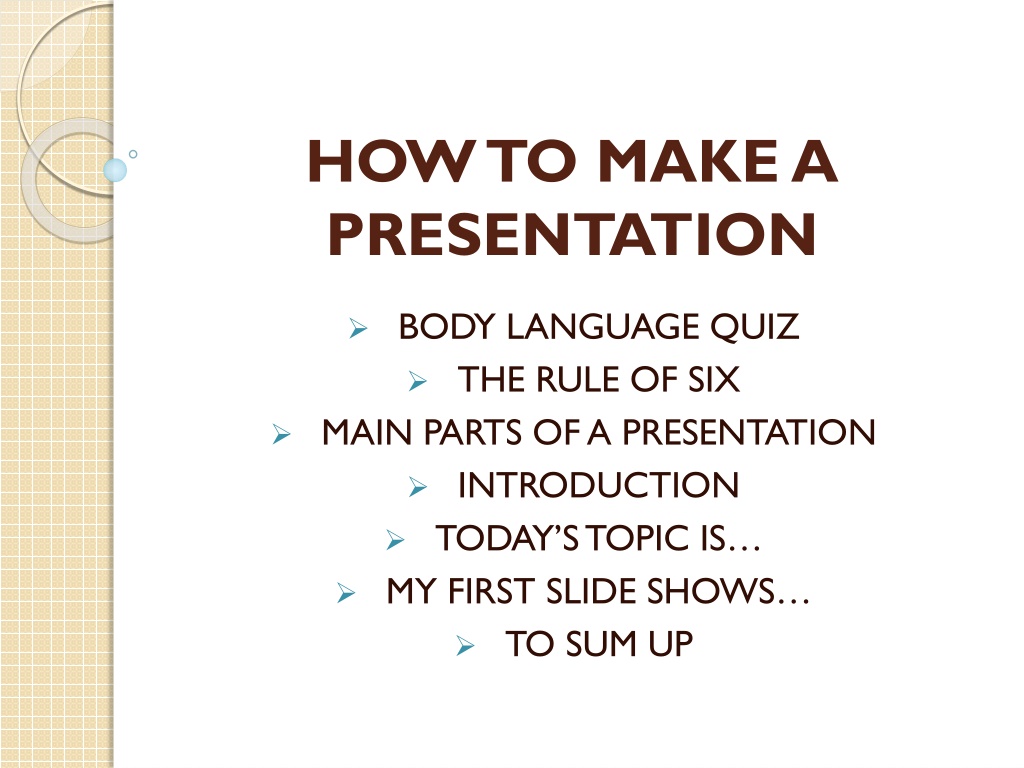








 undefined
undefined






